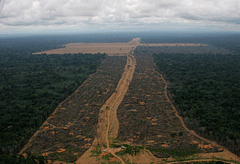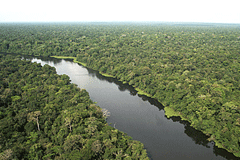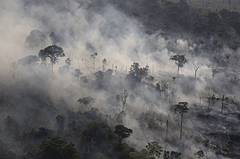Beans Vs. Trees in the Amazon
Air Date: Week of July 11, 2008

In Gleba do Pacoval, 1,645 hectares was illegally logged to clear land for soy plantations. (Courtesy of Greenpeace)
European consumer demand for ethically grown food has forced a moratorium in Brazil that will drastically reduce new deforestation for growing soy beans. Host Bruce Gellerman talks with Lindsey Allen, a forest campaigner for Greenpeace.
Transcript
GELLERMAN: The price for soybeans is soaring as more and more soy is being used to replace petroleum. These days you’ll find the flexible bean in everything from plastics to gasoline. With increased demand comes increased pressure on farmers to plant soy wherever they can - and even places they’re not supposed to, like Brazil’s Amazon Rainforest. That’s why a new agreement to ban soybeans grown in the rainforest could play a big role in preserving the region. The moratorium removes the farmers’ economic incentive. Lindsay Allen of Greenpeace helped broker the deal. Hi Lindsay!
ALLEN: Hi Bruce.
GELLERMAN: So how does this moratorium work?
ALLEN: Well the moratorium works by ensuring that there isn’t new deforestation in the Amazon for soy and it sets in place the monitoring mechanisms so that the big traders like Cargill, ADM, and Bunge can know that the soy they’re getting and sending to market isn’t coming from farmers who have deforested.

An aerial view of the Amazon rainforest (Courtesy of Greenpeace)
ALLEN: It’s their economic interests because before we announced the moratorium we released a report called “Eating up the Amazon.” And it was essentially a case study that walked from soy in the hands of the farmers to the hands of Cargill, Cargill would then send it to Europe to be animal feed, and those animals were then going into McDonalds’ chain of custody. So the pressure that we were able to exert on McDonalds they in turn exert on Cargill. And knowing that deforestation of the Amazon not only is devastating to biodiversity but it also has an impact on climate change, given Brazil is the fourth-largest greenhouse gas emitter, McDonald’s has European customers who refuse to buy Amazon soy.
GELLERMAN: Well why now? I mean these farmers have been cutting down the forest to grow food for years. What’s the impetus for the action now?

Farmers burn unwanted trees to add nutrients to the soil and prepare it for agricultural domestication. (Courtesy of Greenpeace)
GELLERMAN: But with the world price of commodities, particularly soy, going up so high, wouldn’t it make sense to have farmers cultivate more soy and bring the price down? I mean there’s people that are going to go hungry because they won’t have soy products.
ALLEN: Not necessarily. So Brazilian soy is cheaper to grow in the Amazon because people are grabbing land, they’re growing soy in protected areas, they’re growing soy in ecological reserves, and they’re not paying for this land. They’re also not paying for the workers often times so we see a large intersect between slave labor and soy being grown because of these illegal operations that are moving into the Amazon. When soy was first introduced in Brazil it wasn’t thought that it would be able to grow in the Amazon because of the climatic and the soil conditions, it was assumed that it would have to stay in the south and so it is a pretty recent surge that we’ve seen in moving soy into the Amazon itself.

In Gleba do Pacoval, 1,645 hectares were illegally logged to clear land for soy plantations. (Courtesy of Greenpeace)
ALLEN: Well we don’t look at the soybean we look at the farm. So the mapping and the monitoring and the land registration all go together and what we do is we want to have maps to a scale where we can, as soon as we see deforestation happen, we note it. We know who owns that land, we know what has been planted there, we know if it’s related to cattle grazer, rice production, soy production, and we then essentially blacklist those farmers so that the traders know that they cannot buy from these farmers even if part of the farmer’s land has been used legally to grow soy if they’ve deforested a new area they will be blacklisted and the traders have agreed to this as part of the moratorium.
GELLERMAN: Lindsay I understand that Brazil is going to extend the soy moratorium to include timber and cattle. Is that true?
ALLEN: We hope so. The way that soy works is it’s not planted right away. First they’ll go in, they’ll have someone come in and log them or they’ll log themselves for the timber that is most profitable. The next step would be because there’s still stumps and there’s still brush that needs to be removed they get someone to clear the land a bit more, being able to plant grasses, and then they can bring in cattle to ranch on that area. And eventually they can use the cattle that they get to market to pay folks to come in, take out the stumps, and plant rice, and really domesticate the soil so that it can grow soy because soy right now is the most profitable crop to get to market. Our goal in working with the Brazilian government is to really get them to sign on to a zero deforestation platform because the Amazon not only is it important to biodiversity but also for preventing catastrophic climate change.

Lindsey Allen is a forest campaigner with Greenpeace. (Courtesy of Lindsey Allen)
ALLEN: They did, that was in the state of Pará and it was part of, it was sending out IBAMA, which is essentially the Brazilian EPA with guns and they confiscated the cattle and they’ll be, as long as a judge approves it, they’ll be auctioned with the proceeds going to a hunger program and healthcare for indigenous tribes there.
GELLERMAN: Lindsay you are stepping on some of the biggest toes in the world. Isn’t Greenpeace afraid of being there?
ALLEN: It is dangerous to be in the Amazon but we have a tremendous responsibility to protect such an important ecosystem not just to secure such a biodiverse place but also to limit the impacts of climate change. So Greenpeace has been in the Amazon for quite awhile. We have an office right in the middle of things, and it’s heavily guarded, and we do take security precautions but it’s important for us to be there.
GELLERMAN: Lindsay Allen is a forest campaigner with Greenpeace. Lindsay, thanks a lot.
ALLEN: Thank you.
Links
Living on Earth wants to hear from you!
Living on Earth
62 Calef Highway, Suite 212
Lee, NH 03861
Telephone: 617-287-4121
E-mail: comments@loe.org
Newsletter [Click here]
Donate to Living on Earth!
Living on Earth is an independent media program and relies entirely on contributions from listeners and institutions supporting public service. Please donate now to preserve an independent environmental voice.
NewsletterLiving on Earth offers a weekly delivery of the show's rundown to your mailbox. Sign up for our newsletter today!
 Sailors For The Sea: Be the change you want to sea.
Sailors For The Sea: Be the change you want to sea.
 The Grantham Foundation for the Protection of the Environment: Committed to protecting and improving the health of the global environment.
The Grantham Foundation for the Protection of the Environment: Committed to protecting and improving the health of the global environment.
 Contribute to Living on Earth and receive, as our gift to you, an archival print of one of Mark Seth Lender's extraordinary wildlife photographs. Follow the link to see Mark's current collection of photographs.
Contribute to Living on Earth and receive, as our gift to you, an archival print of one of Mark Seth Lender's extraordinary wildlife photographs. Follow the link to see Mark's current collection of photographs.
 Buy a signed copy of Mark Seth Lender's book Smeagull the Seagull & support Living on Earth
Buy a signed copy of Mark Seth Lender's book Smeagull the Seagull & support Living on Earth

